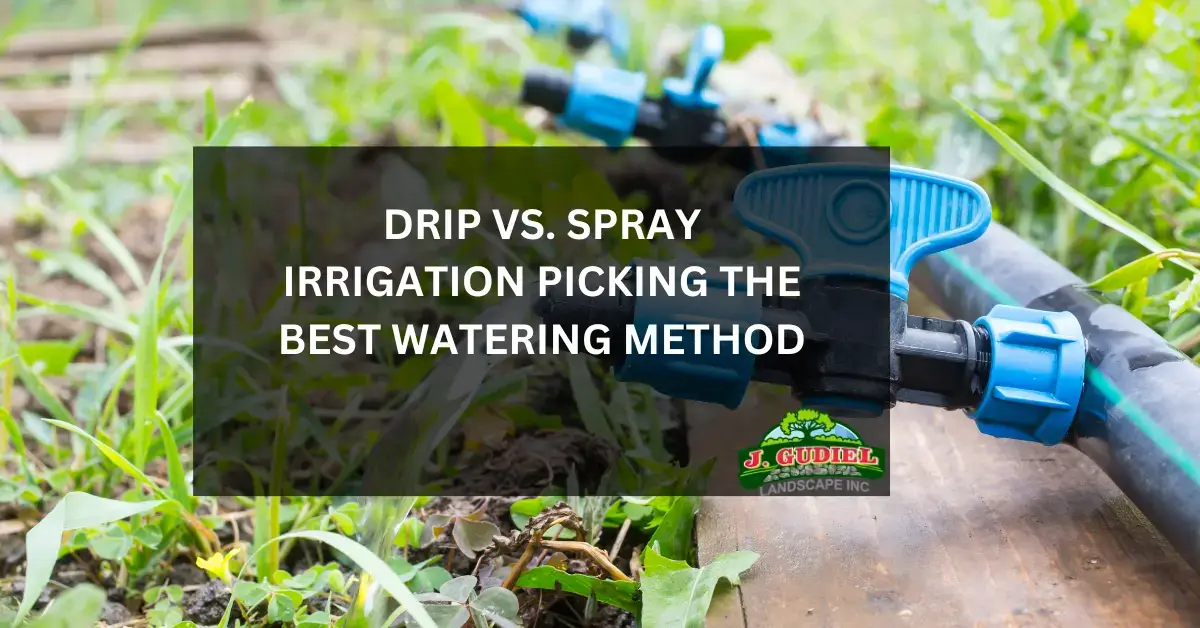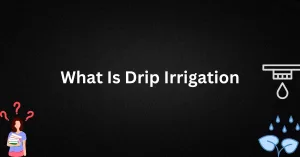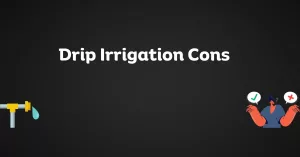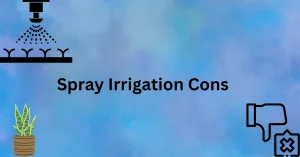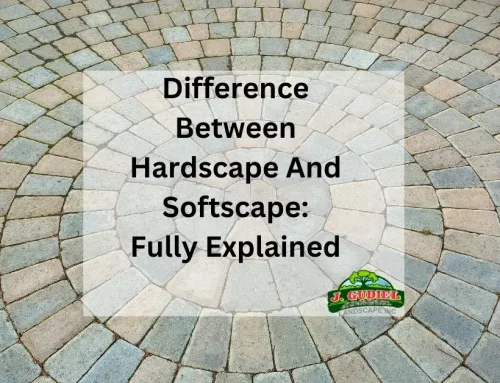When watering your plants, you’ve got options for drip vs spray irrigation. But which one’s better? Let’s find out! In this short guide, we’ll look at drip and spray watering basics. Whether you’re a farmer, gardener, or just curious, understanding these systems will help you save water and grow healthier plants. Ready to dive in? Let’s go!
Firstly, let us tell you what they are, for better information.
What is Spray Irrigation
Spray irrigation water plants over the soil surface in a fine mist or shower. It’s like using a sprinkler to water your lawn. The water is distributed over a wide area, covering the plants and soil. While spray irrigation is easy to set up and works well for large areas like fields or lawns, it can lead to water loss through evaporation and runoff. This method is commonly used in agriculture, landscaping, and residential yards to keep plants hydrated and healthy.
Now, let’s talk about the pros and cons of drip irrigation.
Drip Irrigation Pros
Water Efficiency
Drip irrigation minimizes water waste by delivering water directly to the plant roots, reducing evaporation, runoff, and overspray.
Customization
It offers the flexibility to tailor water delivery to the specific needs of different plants, crops, or areas, ensuring optimal growth and water usage efficiency.
Weed Control
Point source drip zones help suppress weed growth by delivering water only to the desired plant roots, minimizing competition for water resources.
Cost-effectiveness
By conserving water, drip irrigation systems significantly save utility bills over time, making them a cost-effective choice for both small and large-scale applications.
Disease Prevention
Drip irrigation reduces the risk of plant diseases, such as powdery mildew, by keeping foliage dry and delivering water directly to the soil.
Low Maintenance
Drip irrigation systems require minimal maintenance compared to other methods, saving time and effort for gardeners and farmers.
Environmentally Friendly
With its targeted water delivery, drip irrigation reduces the environmental impact of excess water usage and runoff, contributing to sustainable agriculture practices.
Scalability
Drip irrigation systems can be scaled to accommodate various sizes of planting areas, from small gardens to vast agricultural fields, providing consistent and efficient watering solutions for different needs.
Drip Irrigation Cons
Vulnerability to Damage
Drip irrigation systems are susceptible to rodent damage, such as dogs, squirrels, mice, and rats, and accidental contact with garden tools, mowers, or animals. The tubing above ground increases this risk, as exposure to UV rays weakens the plastic, leading to cracks and potential leaks.
Root Overgrowth
Roots can infringe upon the tubing, hindering system efficiency and making future adjustments or maintenance challenging. This can result in reduced water flow to plants and potential damage to the tubing during attempts to clear root obstructions.
Clogging Concerns
Sediment in the water can clog the system’s small openings and filters, impacting plant water distribution. If left unchecked, clogs can lead to plant stress or even death due to insufficient water supply.
Visibility and Aesthetic Issues
Above-ground placement of drip irrigation components can detract from the visual appeal of the garden or landscape. While some gardeners attempt to conceal the system with mulch, this can impede visibility for maintenance and monitoring purposes.
Dependence on Plant Health
Inspecting drip irrigation effectiveness relies heavily on monitoring the health of plants, as the system’s underground components are not easily visible. Any inefficiencies or malfunctions may only become apparent once plants show signs of stress or damage, potentially leading to delayed detection and corrective action.
Now let’s talk about the pros and cons of Spray Irrigation.
Spray Irrigation Pros
Covers Big Areas
Spray irrigation can water large spaces quickly and effectively because it sprays water over a wide area.
Works Anywhere
Spray irrigation can be adjusted to accommodate different soil types, slopes, and plant varieties, showcasing its versatility.
Fast and Cool
It waters plants fast and can cool down hot areas, which is excellent for plants and animals in warm weather.
Looks Nice
Spray irrigation can make gardens and parks look better with its rhythmic sprinkler movements and the way water droplets sparkle.
Protects from Frost
On farms, it can even help stop crops from getting damaged by frost by spraying water on them when it’s freezing outside.
Easy to Take Care of
Maintaining spray irrigation is simple. You must clean the nozzles, adjust the spray, and check for leaks regularly.
Saves Money
Setting up or running spray irrigation systems is not too expensive, especially for significant areas. The parts are affordable, and you don’t need fancy tools to keep it running smoothly.
Spray Irrigation Cons
Water Waste
Spray irrigation can lead to water wastage due to evaporation, wind drift, and runoff. Only some water sprayed reaches the plants, leading to inefficiency, especially in windy conditions.
Uneven Distribution
While spray irrigation covers large areas, it may only distribute water evenly across some regions. Some areas may receive too much water, causing soil erosion and nutrient leaching, while others may not receive enough, leading to uneven plant growth.
Dependency on Weather
Spray irrigation systems are sensitive to weather conditions such as wind speed and direction. High winds can cause water drift and uneven coverage, while rain can render irrigation unnecessary, resulting in water wastage if the system needs to be correctly adjusted or turned off.
Potential for Disease Spread
Wet foliage from spray irrigation can create favorable conditions for spreading plant diseases, particularly fungal infections. Constant moisture on leaves can promote the growth of pathogens, increasing the risk of disease outbreaks.
Energy Consumption
Spray irrigation systems typically require pumps to generate enough pressure to propel water through the nozzles. This reliance on pumps can increase energy consumption, operational costs, and environmental impact, primarily if non-renewable energy sources power them.
Maintenance Needs
Spray irrigation systems require regular maintenance to ensure proper functioning. Nozzles can become clogged with debris, leading to uneven water distribution and reduced efficiency. Components such as pumps and valves may also require periodic inspection and repair to prevent system failures.
Limited Application in Sloped Areas
Spray irrigation may not be suitable for sloped terrain due to the risk of water runoff and soil erosion. In such areas, alternative irrigation methods like drip irrigation or contour farming may be more effective in conserving water and preventing soil loss.
Now, here comes the main thing: Drip vs Spray Irrigation. So, let’s talk about it.
Bonus
Drip vs Spray Irrigation
Comparing drip and spray irrigation systems:
Drip Irrigation:
Water Efficiency
Drip irrigation delivers water directly to the root zone of plants, minimizing water loss due to evaporation and runoff. It’s highly efficient, as water is applied precisely where needed.
Soil Conservation
Drip irrigation reduces soil erosion and nutrient leaching by delivering water directly to the root zone compared to surface watering methods like spray irrigation.
Ideal for Sloped Terrain
Drip irrigation is well-suited for sloped terrain where spray irrigation may lead to water runoff and soil erosion. It allows for controlled water application, even on uneven surfaces.
Less Prone to Disease
Drip irrigation keeps foliage dry, reducing the risk of fungal diseases compared to spray irrigation, which wets leaves.
Low Maintenance
Drip irrigation systems require minimal maintenance once installed. However, periodic checks for clogs and leaks are necessary to ensure proper functioning.
Spray Irrigation
Quick Coverage
Spray irrigation covers large areas quickly and is ideal for open spaces like lawns and sports fields where uniform coverage is desired.
Visual Appeal
Spray irrigation can enhance the aesthetic appeal of landscapes with its rhythmic sprinkler movements and sparkling water droplets.
Cooling Effect
In addition to watering plants, spray irrigation can provide a cooling effect, making it suitable for hot climates.
Frost Protection
Spray irrigation can help protect crops from frost damage by applying water during freezing conditions, releasing heat as water freezes.
Easy Installation
Spray irrigation systems are relatively easy to install and suitable for various applications, including residential gardens, parks, and agricultural fields.
Conclusion:
Drip vs spray irrigation, it’s clear that each has its strengths and weaknesses. Drip irrigation excels in water efficiency and soil conservation, making it ideal for areas with sloped terrain and a focus on water conservation. On the other hand, spray irrigation offers quick coverage and visual appeal, and it is suitable for various applications but could be more efficient in water usage. The choice between the two depends on factors such as water conservation goals, terrain characteristics, and plant requirements, with potential benefits in integrating both systems for optimal irrigation solutions.
For more exciting content, follow us on Yelp Facebook Instagram.
FAQs:
Q1: Which saves more water, drip vs spray irrigation?
A: Drip irrigation saves more water by delivering water directly to plant roots, minimizing evaporation and runoff.
Q2: Where is drip irrigation best used compared to spray?
A: Drip irrigation suits areas with water scarcity, slopes, and where water conservation matters. Spray is better for large open spaces like lawns and parks.
Q3: Which is easier to maintain, drip or spray?
A: Drip irrigation is generally easier to maintain, with fewer parts prone to clogging. Spray systems may require more frequent nozzle cleaning for uniform water distribution.

